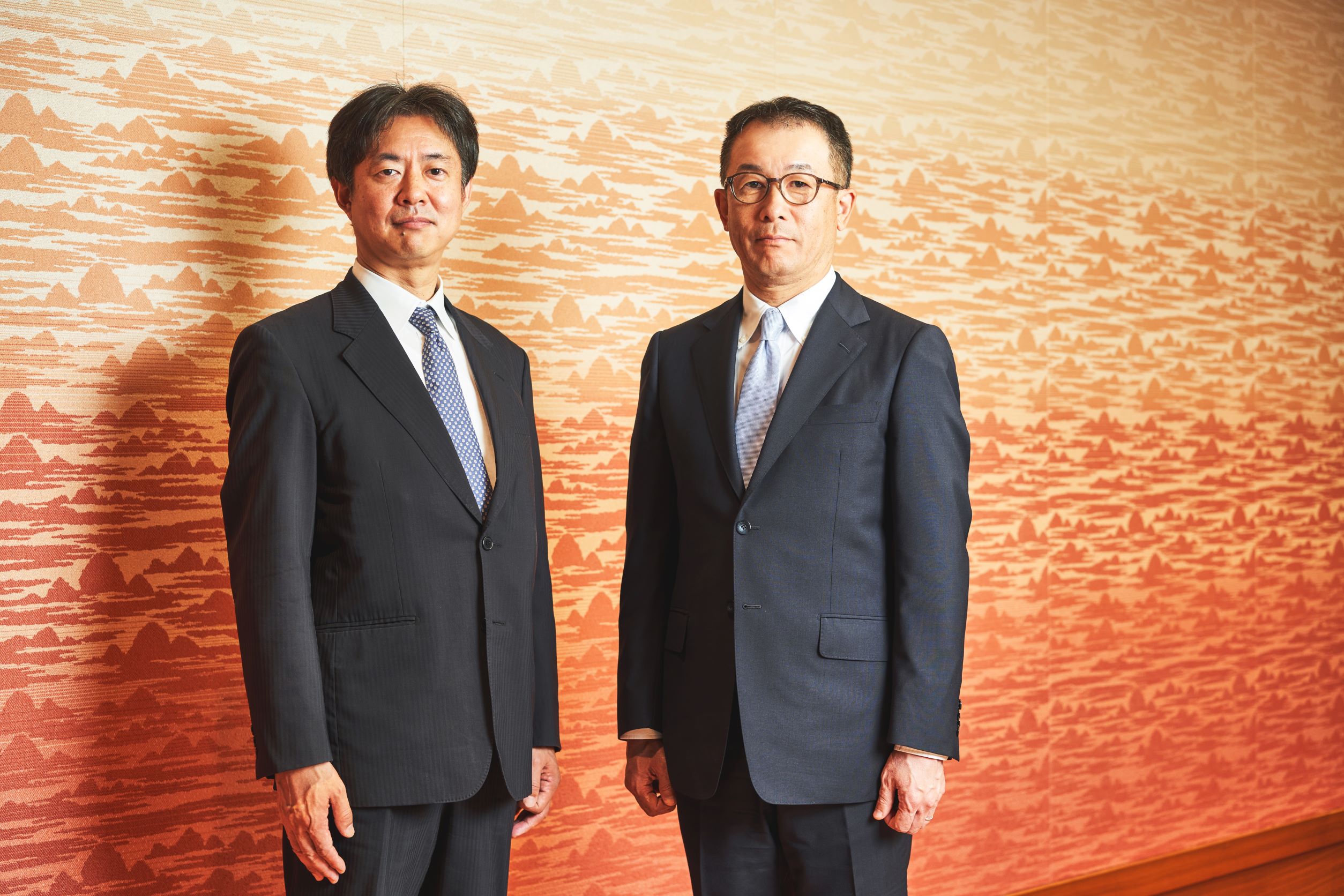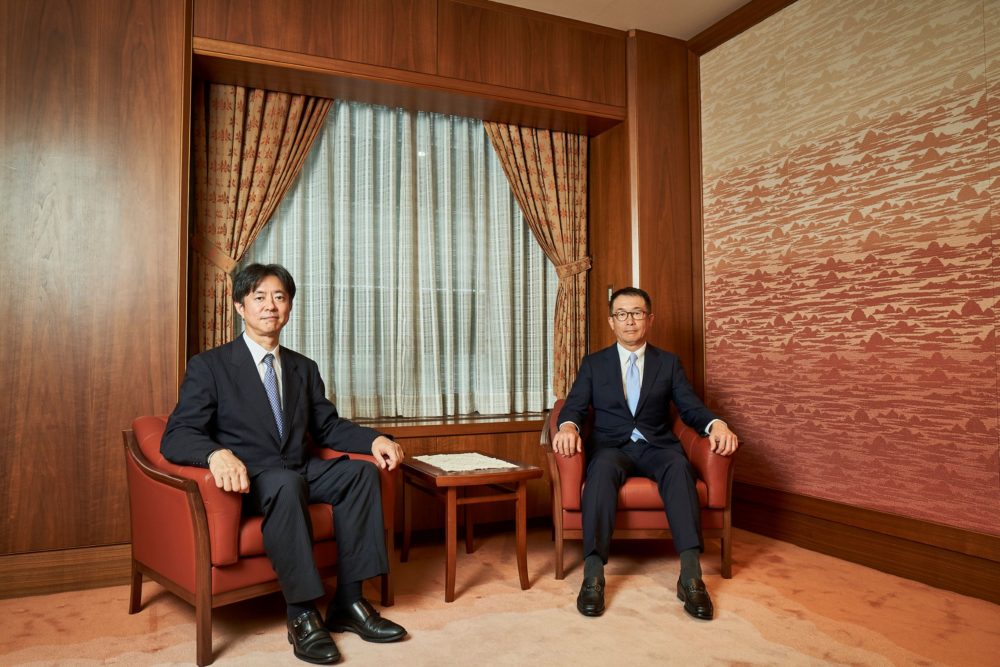
MUFG × DI: Working together to deliver new values, navigate and embrace change without fear
This article gives an interview between 2 leaders of Mitsubishi UFJ Financial Group (MUFG) and Dream Incubator (DI) where they come together to discuss in depth the history of their collaborative relationship, focused thematic areas to be addressed in future initiatives, and potential social impact generated through a joint effort launched from 2022.
Interviewee Profiles
Mr. Naomi Hayashi
- Senior Managing Corporate Executive at Mitsubishi UFJ Financial Group;
- Member of the Board of Directors, Deputy President at MUFG Bank, Ltd.;
- Group Head, Japanese Corporate & Investment Banking Business Group of MUFG Bank, Ltd.;
Mr. Takayuki Miyake
- Representative Director & COO at Dream Incubator Inc.;
“Our goal is to change the present megabank architecture with DI’s “intellectual” support” (Mr. Hayashi)
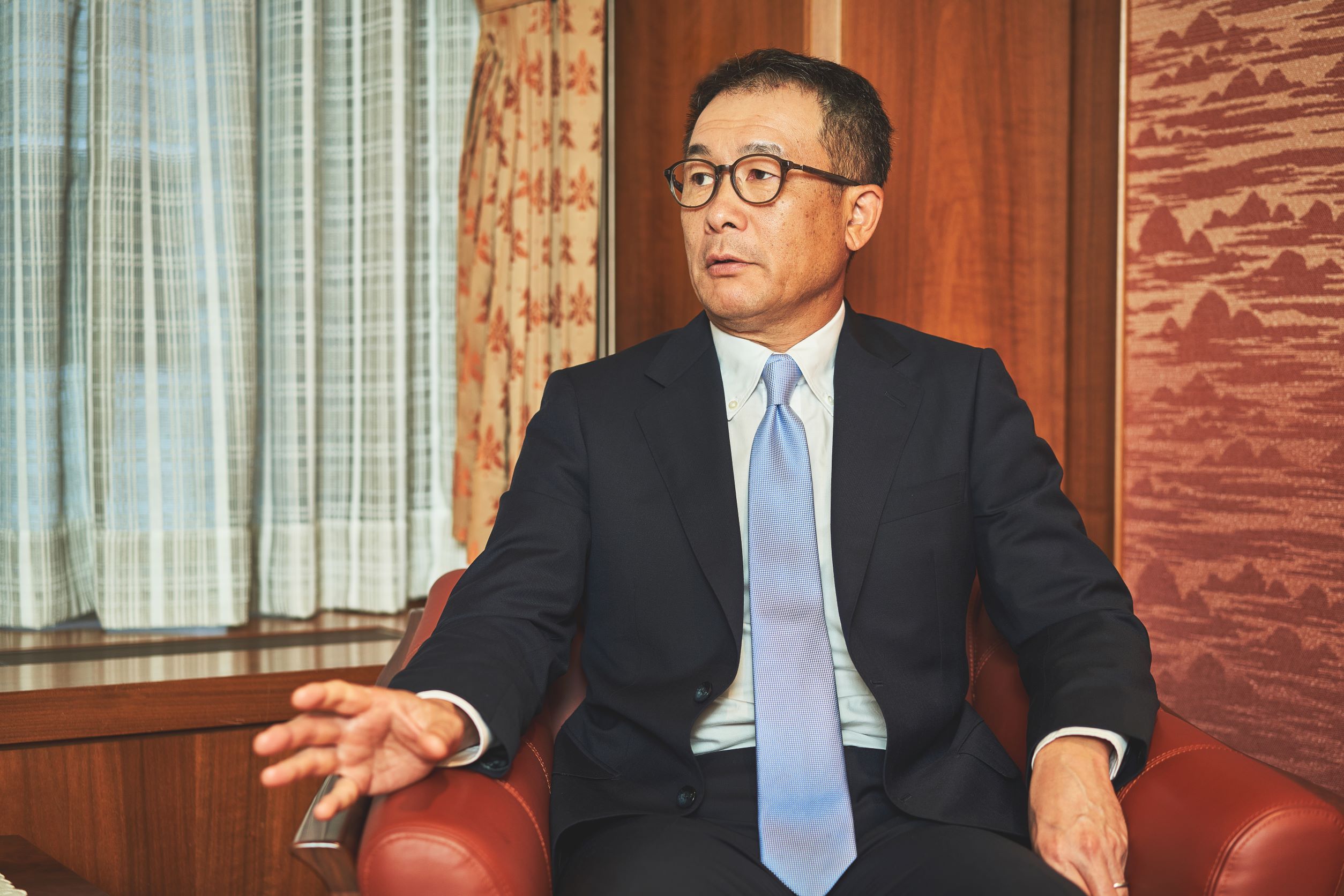
So, how have MUFG and DI started working together?
Mr. Miyake:
I had one of my first conversations with Hayashi-san maybe 7 or 8 years ago. He contacted us after learning about our lenses of “business produce” and “industry produce,” which seemed to have fascinated him. I remembered I told him that banks would fall on hard times if they kept clinging to outdated business models.
There are numerous examples about new industries being created as a result of restructuring pre-existing industries or changing the norms. I also said to him at the time that an active engagement to plant more business seeds would naturally allow banks more opportunities to offer financing, even though initially it may not be apparently an industry but rather a business.
However, it is challenging to reconfigure the arrangements of pre-existing industries as the process will involve a lot of efforts to enable or change connections between components; and here finance is key to shaping the new norms. Hayashi-san has therefore suggested to “embed” DI’s capabilities and approaches. We started making a set of preparations in 2021 to add new business units within MUFG. Established in April 2022, these new divisions are now fully operational.
Mr. Hayashi:
I have been working with several different consulting firms. Though their concepts are very impressive in many ways, I have a feeling that what’s being done are mostly commoditized. We need to capture the larger actions to bring our strategies and tactics to life, and the partnered consulting firm should work hand-in-hand with us to ensure harmonization and alignment with government policies, strategic directions, and rules of the country; nothing will actually change with just empty words. I’m not quite sure how to word it, but I associate DI with a high level of “combat power.” Coupled with the ability to craft actionable strategies, they seem to have access to people who attempt to create their own rules.
So, what is our role? After serving as the Group Chief Strategy Officer, I got out to the front line and listened to clients’ stories. I learned that our clients had little to no expectations about mega financial groups, particularly banking institutions. It’s as if as long as the interest rate on loans is maintained at the desired level, that would suffice.
Every client has an individual set of challenges – that goes without saying – from reviewing company’s portfolio, starting new ventures, navigating environmental and energy transition, digitizing internal processes, to coping with hyperinflation. The list just goes on forever. Whom do they turn to when they need advice in those situations? It’s usually consulting firms or private equity funds, not banks.
However, to shift the expectations placed on our role, there is a need to have a good grasp of what the realities of our clients’ businesses are, then venture out on the business battlefield with the clients right next to us; if not, our raison d’etre would be lost.
To unleash our full capabilities for that, I suppose the shortest possible shortcut would be to engage with companies with a strong implementation competencies and intellectual capital like DI.
According to the mid-term management plan, the Japanese Corporate & Investment Banking Business Group aims at “sharing risks, sharing growth with clients.” Could you explain?
Mr. Hayashi:
My former supervisor at MUFG – the Head of Loans Department, boastingly told me, “We used to assess loan applications based on the value of bonsai trees/construction machinery held by directors or organizations seeking financing options. This meant loans were offered after gauging the value of “things.” On second thought, today’s banks are no longer able to do so. Our role and expectations for us have fallen drastically since the idea of examining values of tangible assets was abandoned.
Despite the fact that our clients provided us with their balance sheets, we usually took the easy way by assigning a zero value to asset accounts that we were uncertain about. About 20 years ago, there were many loan applications where we internally decided that a borrower had a net asset deficiency.
Ever since, I was solely concerned in liabilities section of the client’s balance sheet and the cash flows expected to be generated yearly to pay off debt. Partly due to the role allocation between banks and securities firms, I am not very interested in the value of capital on their balance sheets; as long as their liabilities are circulated in a healthy and neat condition, that’s all that matters.
Reflecting on past bubbles, we narrowed our own role and failed to act as a consulting firm nor an advisor like private equity funds for our clients; then, we increasingly lost our role and client expectations with negative interest rates and dormant capital. In formulating a solution to the issue, we may need to join forces with an intellectual squad like DI to brainstorm and exercise new ways of sharing risks with clients.
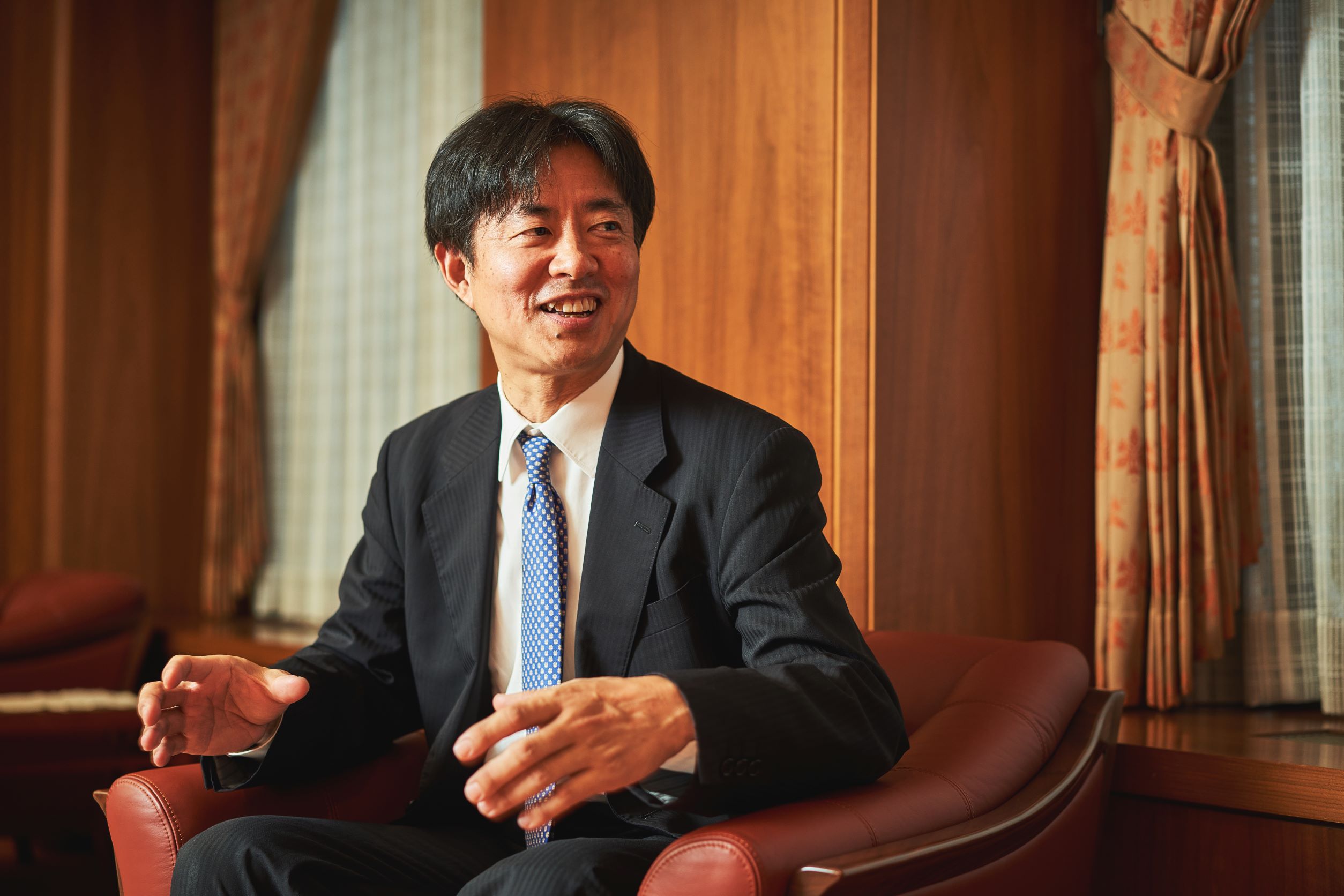
“The power of deep thinking, untangling the fabric that makes up our world, and making accurate investment decisions are pivotal.” (Mr. Miyake)
Associating DI’s strengths with “combat power,” Hayashi-san has decided to add the “Industry Research and Creation Division” and “Business Co-Creation Division” in MUFG’s organization
Mr. Hayashi:
Due to Japan’s large current account surplus for several decades, the acts of borrowing and lending money become more common. Still, our kind clients continue to count on us, just like they always do. Yet we are too oblivious to realize it and just stay with the inertia-driven status quo. The approach that Miyake-san mentioned earlier is absolutely necessary for us to escape from this predicament.
20 years ago, our Sales Divisions were structured and specialized by industry, mimicking the organizational structure of an investment bank. However, due to differences between the 2 types of banks, restructuring a commercial bank that way brought no discernible impact other than a commonly shared sense of familiarity when attending financial briefings. As a result, an individual in charge of a particular sector had no clue about other arenas outside of their area of specialization.
Today, we need to address horizontal thematic areas, which cut across multiple economic sectors, such as digital transformation, environmental protection, and energy. We will not be able to effectively exploit our customer base and meet their needs without chaining the vertical industry-specific responsibilities to horizontal themes. Hence, the defined role of the “Industry Research and Creation Division” and the “Business Co-Creation Division” is to create these cross-sectoral chains.
Specifically, the Industry Research and Creation Division covers a range of cross-sectoral topics, such as environment/energy, food loss, semiconductors/quantum computing, and space business, some of which Miyake-san and his team have long been eyeing for a while now. For example, tackling cross-cutting issues and breaking new ground in the realm of power transmission and distribution may help reinvigorate our industry-specific organizational structure.
The absolute worst thing we can do is to turn this new team into a mere research group. We should go further than simply submitting research findings to our clients, by actively taking risks to actually do something in the real world. That is why we also establish the “Business Co-Creation Division” as an investment arm.
Mr. Miyake:
It seems to us that Hayashi-san has reflected his awareness of unresolved issues into the form of an organizational structure. With Hayashi-san leading the Japanese Corporate & Investment Banking Business Group, several amazing initiatives have been executed at an ever-accelerating pace (laugh). It feels like the image keeps growing in his head.
I totally agree that having 2 separated departments – one for pursuing focused themes, and one for making investments – would be preferable. To run the “Industry Research and Creation Division,” we should be able to think deeply into the hidden dimensions of details of life. Moreover, it is imperative to have meaningful discussions with relevant government offices in Kasumigaseki and Nagatacho, as well as with other stakeholders.
DI has experienced both the ups and downs of venture capital investments for over 2 decades active in the market. I believe we have made the right decision having 2 new separated divisions, given the difficulties we would encounter as an investor are fundamentally different from those of market research and business produce in terms of mindset.
Mr. Hayashi:
The Japanese Corporate & Investment Banking Business Group has a top-line gross profit of approximately 600 billion yen. There is a net operating income of approximately 300 billion yen, equivalent to income earned by a regular company. Majority of the top line and profits is attributable to recurring revenue streams from loan and deposit operations which total 40 trillion yen each. These operations fall under the umbrella of the Sales and Trading Divisions and other frontlines responsible for major corporate transactions.
Our CEO Hironori Kamezawa often uses the term “ambidexterity.” He believes business is not a business without either the “exploration” into untapped markets or the “exploitation” of existing recurring revenue model. Whilst we are working with DI on the latter – with high hopes that the efforts we are making one day start to bear fruit, we must not overlook the critical importance of further monetizing our assets over the next 5 years or so.
Also, we need to give people at the Japanese Corporate & Investment Banking Business Group a clear sense of hope for the future and scale new business while simultaneously boosting profitability. Therefore, from the management’s perspective, it will be a big mistake if we solely put our concentration and focus on new initiatives. I hope that point comes through clearly.
Among new initiatives, I believe that an accurate measurement of tangible assets’ worth will lead to the “exploitation” of recurring-revenue-driven business. I have really high expectations that we will abandon the mindset heavily dependent on changes in external credit ratings and prior practices and shift to a pricing model that is based on business forecasting.
“Hayashi-san is able to transcend industry conventions and see things with a perfect bird’s eye view.” (Mr. Miyake)
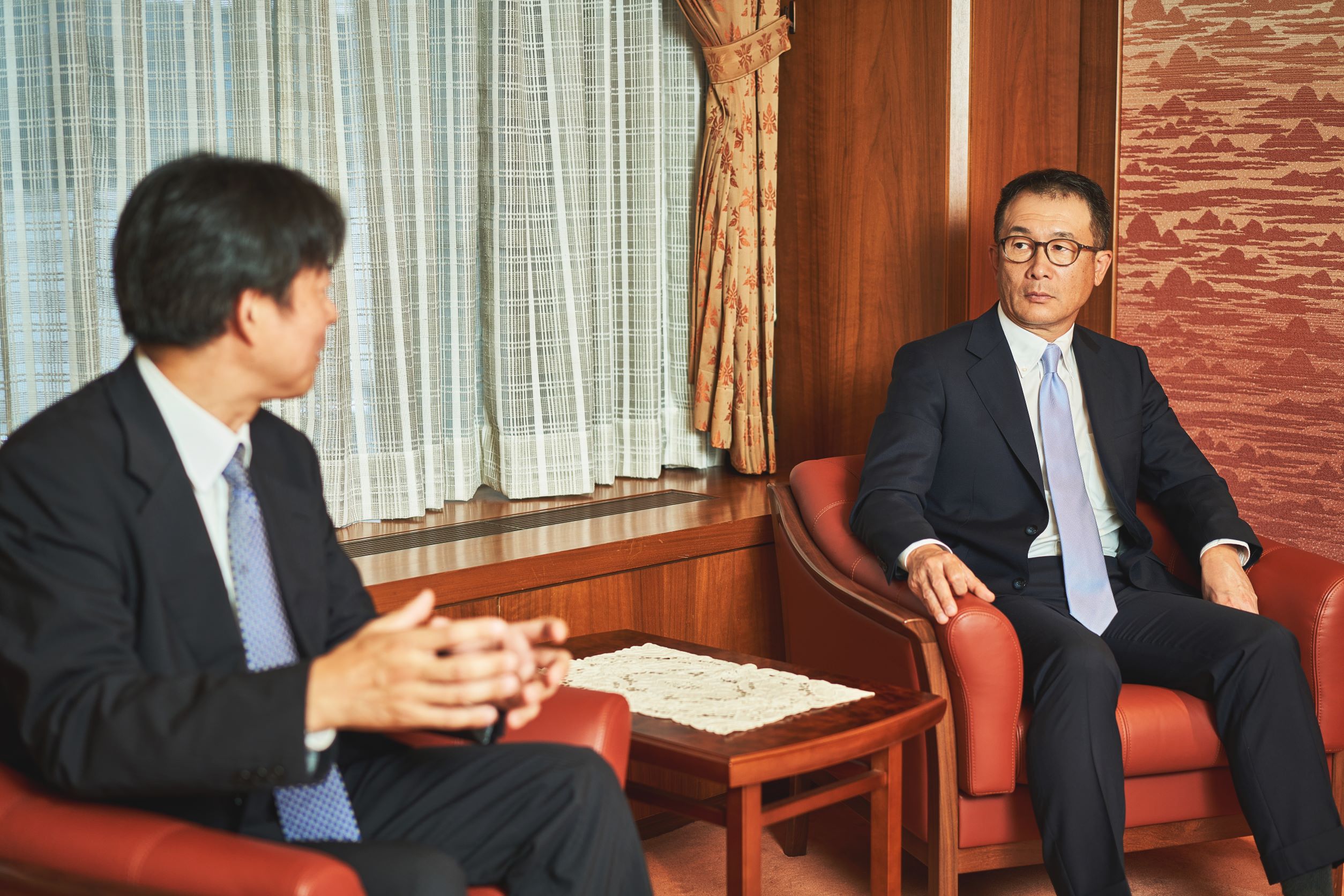
What do you think is the significance of creating new divisions with DI?
Mr. Hayashi:
Although our bank as a whole has huge deposits at hand, only around half of the funds are considered suitable for lending activities. The remaining 100 trillion yen is a circulation of funds between the Bank of Japan and us; nevertheless, that has very little significance from the standpoint of finding practical solutions to societal problems.
Japan now also faces a current-account deficit. For our business to remain sustainable, we need to withdraw money from the Bank of Japan’s current accounts and use that cash to benefit society as a whole. Japan and us are two inseparable sides of the same coin, so if the country collapses, we too would. To prevent this from happening, I firmly believe we need to work with DI as we need to get the financial intermediary functions right.
What potential does DI see in the megabank MUFG?
Mr. Miyake:
It is common for people in any industry to have convention-bound views and take actions within the confines of traditional industry practices and norms. However, a fresh different way of thinking beyond those boundaries – for example, a combination of multiple industries such as healthcare, automobiles, and digital technology – could be a conduit for giving birth to new businesses. Few people seem to take that big-picture approach, but Hayashi-san does. Having such perspective and approach is very, very valuable.
Also, this is exactly the same problem the government is also facing. Public policies and programs (created by the national government, i.e., the primary policy maker) may not be as effective in delivering intended outcomes without profound proposals stemming from the private sector for “producing” high-impact industries and businesses. When I told Hayashi-san that this situation would leave the government nothing but fear, “That’s not easy,” he said, “We have to create something great and provide some input.”
I have accompanied Mitsubishi UFJ Financial Group and MUFJ Bank on visits to many different business organizations to discuss aspects of business proposals. They welcome us differently than when we go alone (laugh), or, more precisely, we are taken very seriously.
I think megabanks now still wield significant power. I believe that together, we can achieve interesting outcomes as long as we can further complement the combination I mentioned earlier. DI may have some expertise and “combat power,” but there are undoubtedly certain areas where we just cannot overcome on our own; thus, having a solid leverage will be very empowering.
Do you have a specific timeline or roadmap for the two companies to follow?
Mr. Hayashi:
I refer to it as “staircase management.” Regardless of how well we prepare ahead of time, shocking events such as the invasion of Ukraine can change all the rules of the game in the international arena. Therefore, we focus not on medium- to long-term plans, but on actual year-on-year improvements to ensure profit growth.
Thus, we do not determine a specific timeframe for our collaborative efforts. Rather, just evolve from yesterday, which is the only metric that really counts. In this regard, being able to accurately understand, add value, and quantify the reality of business could expectedly shape potential discussions/negotiations we have with our clients.
“Borrow DI’s brains and define a new raison d’etre to embrace change without fear” (Mr. Hayashi)
This is a question for Miyake-san. Do you have certain thematic areas in mind that will drive future initiatives of the “Industry Research and Creation Division” and “Business Co-Creation Division?”
Mr. Miyake:
The Industry Research and Creation Division members’ interests have converged around some key issues: declining birthrate/aging population, natural resources, and food loss. Although lower fertility and population aging are particularly pressing issues, effective solutions are yet to be found. It is innovative for a bank to try tackling gigantic problems like lower birth rates and aging society. There should be an opportunity there.
The Business Co-Creation Division began operations last year, before it was officially added to the organization. We have been visiting many MUFG’s clients and presenting them with different business proposals. I believe MUFG is taking very different initiatives from what it has always been doing. Chances are MUFG clients may also be engaged in the future.
Could you go into more details on your solutions to declining birthrates and aging populations?
Mr. Miyake:
I believe that the government has its countermeasures in place to deal with the said issue, especially subsidies for nursing care, under the category of “costs.” As long as it is considered a cost, many people will, more often than not, arrive at the conclusion that the money spent on healthcare and medical service providers should be as low as reasonably practicable. And when this is the case, the industry will not evolve.
For instance, mom-and-pop businesses are currently going through a very tough time. However, if they are to sharpen their edge by working on operational efficiency and manualized protocols/standardization like convenience stores, their brand/product power as well as profitability would increase as a result, leaving room for further investments to be done. I suppose the service industry can earn foreign currency from overseas in this manner.
In other words, rather than seeing healthcare and medical expenses as a cost, we should consider them an investment to create an industry. Investment in such industry has the potential to generate growth potential for MUFG, and the same thing could be said of the national level.
Mr. Hayashi:
Miyake-san always has a way of making “business produce” ideas, which is not a perspective banks usually have. We indeed need to learn that.
Also, I think it’s crucial to call attention to issues that seem obvious but their realities are less commonly understood. For example, sometimes you will never know the value of water distribution networks until the systems stop functioning. Fresh water supply to our homes comes through PVC pipes, but few people care what would we need to do once we run out of PVC pipes. We can change the way we see things by taking a deeper dive into the discussion to answer questions such as global PVC pipe cost per meter and their necessity 20 or 30 years from now.
One of the first steps in this direction is to once again reconsider our interpretation of how the safe and secure world we live in today is being created. If we overlook such details to talk about consolidated balance sheets of chemical corporations, we are lacking a holistic perspective on the material supply chain to see what’s actually below the surface. Crafting a framework or system that delves into raw material issues, understands the realities and facts, allows banks to lend money when and where necessary is, in my opinion, vital.
I’ve read a book that states: reducing food waste is ranked as the third most important solution to reverse global warming while alternate refrigerants and onshore wind energy top the list. Yet, we don’t talk enough about eliminating food waste in our fight against climate change. We should address those areas and the upstream and downstream linkages.
Mr. Miyake:
Hayashi-san is not hesitant to see things through different lens. I am often astonished to hear him say, “Come to think of it, I suppose you are right.” For our work, the ability to change the angle of approach is crucial. Hayashi-san’s points of view and ideas have significantly helped as we try to find the economic equilibrium point. We are looking forward to seeing how this will add a whole new dimension to the “industry produce” concept.
Before closing this interview, could you leave a message for our readers?
Mr. Hayashi:
We operate on a typical recurring revenue model; therefore, theoretically, it is desirable if yesterday, today, and tomorrow contain no fluctuations. Nevertheless, we live in a world where changes occur at unimaginable speeds. We now face a life-or-death decision – either acquire a new raison d’etre as a megabank, or slowly wither away. Equally important is not attempting to solve problems by staying with the same old knowledge and ways of doing things.
I’m a firm believer in that DI is the right partner to embody this approach. We also bolster our mid-career recruiting efforts and collaborate with external stakeholders to absorb new wisdom, so that via concerted efforts within and beyond MUFG, we could transform more powerfully.
Mr. Miyake:
For DI, “business produce” and “industry produce” are the most essential notions, serving as the seeds for producing new businesses. I was first a little hesitant about working with MUFG on such crucial matters, but now I am delighted that we did. I am thrilled as it all becomes worth it in terms of scale and speed, more than ever. Megabanks may have lost some of its lustre in Hayashi-san’s view; however, amidst difficulty lies opportunity. With a great deal of capability and power already at hand, we work to achieve innovative and sustainable breakthroughs.
